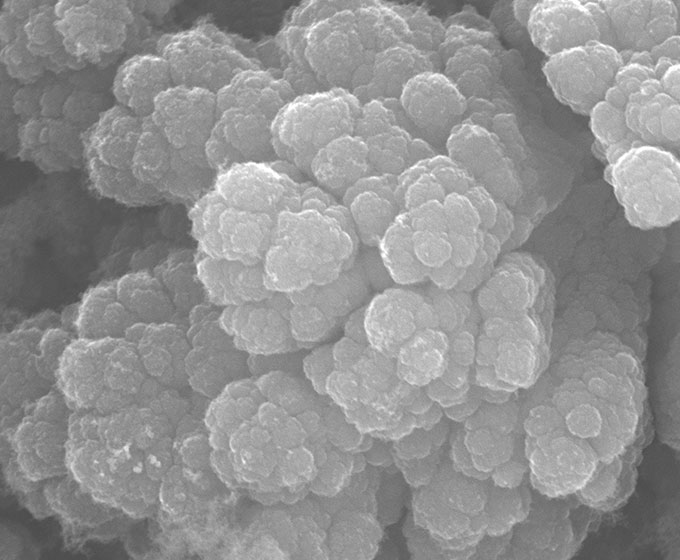
UTSA and Southwest Research Institute will create high surface area carbon microstructure particles that can chemically absorb hydrogen, storing it for safe and cost-effective transport.
AUGUST 1, 2022 — UTSA and Southwest Research Institute are collaborating to improve storage materials for hydrogen fuels with a hybrid metal-carbon microstructure that combines both chemical and physical hydrogen storage mechanisms.
The project is supported by a $125,000 grant from the Connecting through Research Partnerships (Connect) Program and will be led by Josh Mangum of SwRI’s Mechanical Engineering Division, UTSA Associate Professor of Physics and Astronomy Kathryn Mayer and UTSA Assistant Professor of Chemistry Fang Xu.
Hydrogen fuel is an attractive alternative to fossil fuels because its emissions are free from carbon byproducts. SwRI is leading several multidisciplinary efforts evaluating hydrogen as a potential fuel for automobiles, power generation and even as a replacement for natural gas in homes.
“While hydrogen energy is very promising, several hurdles must be overcome,” Mangum said. “Some of the chief challenges are transportation and storage.”
Current methods of transporting and storing hydrogen involve compressing and liquifying hydrogen gas for transport and storage in cryogenic and high-pressure fuel tanks, which is an expensive process. Because hydrogen is highly flammable, transporting these tanks is inherently dangerous.
To address these challenges, SwRI and UTSA will create high surface area carbon (HiSAC) microstructure particles that can physically and chemically absorb the hydrogen, allowing it to be transported safely and cost-effectively.
“Instead of a highly pressurized tank, we plan to store hydrogen in a low-cost powder material,” Mangum explained. “The hydrogen will be chemically and physically absorbed and desorbed. One of our project goals is evaluating how much hydrogen can be stored in the powder since this will dictate the overall storage cost.”
The researchers will fabricate the HiSAC microstructures using the SwRI-developed High Power Impulse Plasma Source (HiPIPS) technology, which efficiently generates coatings using high-density, high-flux plasmas at low temperatures and atmospheric pressures. R&D Magazine recognized SwRI’s HiPIPS technology as one of the 100 most significant innovations of 2017.
UTSA will perform the analytical characterization of the microparticle structures. Mayer’s research team will perform a detailed structural characterization of the materials using state-of-the-art instrumentation in the Kleberg Advanced Microscopy Center. Xu’s team will modify HiSAC by Mg deposition and test the materials’ hydrogen storage capacity using a customized unit.
“Previous research has demonstrated HSAC microstructures at high temperatures and low pressures, but HiPIPS allows us to form these materials at room temperature in a simple, scalable process,” Mangum said. “This process uses less energy than it takes to power an incandescent light bulb.”
SwRI’s Executive Office and UTSA’s Office of the Vice President for Research, Economic Development, and Knowledge Enterprise sponsor the Connect program, which offers grant opportunities to enhance greater scientific collaboration between the two institutions.
UTSA Today is produced by University Communications and Marketing, the official news source of The University of Texas at San Antonio. Send your feedback to news@utsa.edu. Keep up-to-date on UTSA news by visiting UTSA Today. Connect with UTSA online at Facebook, Twitter, Youtube and Instagram.
Move In To COLFA is strongly recommended for new students in COLFA. It gives you the chance to learn about the Student Success Center, campus resources and meet new friends!
Academic Classroom: Lecture Hall (MH 2.01.10,) McKinney Humanities BldgWe invite you to join us for Birds Up! Downtown, an exciting welcome back event designed to connect students with the different departments at the Downtown Campus. Students will have the opportunity to learn about some of the departments on campus, gain access to different resources, and collect some giveaways!
Bill Miller PlazaJoin us for an intimate evening of cocktails, conversation, and culinary inspiration with Pati Jinich, Emmy-nominated chef and James Beard Award-winning author. Enjoy light bites and signature drinks in the warm, modern setting of Mezquite as Pati connects with guests over her passion for Mexican cuisine and storytelling.
Mezquite Restaurant in Pullman Market, 221 Newell Ave., San Antonio 78215From inspired courses to thoughtful pairings and a rich sense of community, the Ven a Comer Signature Dinner is a night of shared meals, shared stories, and unforgettable flavor.
Stable Hall (Pear Brewery), 307 Pearl Pkwy, San Antonio 78215Come and celebrate this year's homecoming at the Downtown Campus with food, games, giveaways, music, and more. We look forward to seeing your Roadrunner Spirit!
Bill Miller PlazaThe University of Texas at San Antonio is dedicated to the advancement of knowledge through research and discovery, teaching and learning, community engagement and public service. As an institution of access and excellence, UTSA embraces multicultural traditions and serves as a center for intellectual and creative resources as well as a catalyst for socioeconomic development and the commercialization of intellectual property - for Texas, the nation and the world.
To be a premier public research university, providing access to educational excellence and preparing citizen leaders for the global environment.
We encourage an environment of dialogue and discovery, where integrity, excellence, respect, collaboration and innovation are fostered.